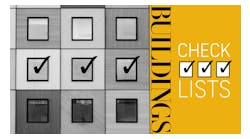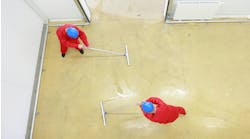Low-Fan Energy Systems Using Dedicated Outside Air Systems (DOAS)
A large part of your energy bill undoubtedly comes from your HVAC system, which is paramount for occupant comfort. But the precision and flexibility of HVAC controls has come a long way to make the technology more efficient.
Jason Siensa, assistant mechanical department manager for Bala Consulting Engineers, walks us through both new and time-tested HVAC technologies that can be used in multiple building types.
Chilled Beams
- Highest energy efficiency (uses 20 percent less fan energy), but highest installation cost
- Delivers ventilation air directly to beam
- Requires chilled and hot water at each beam, so will require central chiller plant and central boiler plant
- Nozzles create a low-pressure area that “induces” room air across the coil, providing sensible cooling with no additional fans
- Induction rate is typically 4:1 or 5:1
- No fan noise or filter changes
- Humidity control is critical
Fan Coils
- Incorporate low-static ECM motors for better efficiency, tighter control of space temperature
- Single-zone or multi-zone systems
- No humidity concerns
- 4-pipe system can cool and heat simultaneously (2-pipe system cannot)
Variable Refrigerant Flow (VRF)
- Distributed energy without a chiller and hot water plant
- All refrigerant based
- Air-cooled or water-cooled condensing units
- Capable of heating and cooling
- Multiple types of interior units (wall-mounted units, horizontal ceiling units, etc.)
- High efficiency ratings
- No humidity concerns
BUILDINGS Education
Hot Strategies for Efficient Cooling
When the temperature rises, your energy bill does too — and if your HVAC system is inefficient, it’s easy to let those bills get out of control. This course will demonstrate how to rein in your energy spending by implementing efficient operation strategies and technologies.
Watch this course on-demand and get CE credits >>
Radiant Floors
- Cools or conducts heat through floor surface rather than air
- Supplemented by DOAS
- Humidity control is critical
- No fan noise or filter changes
- Limitations on cooling capacity
Heat Pumps
- Conventional (cooling tower) or geothermal (ground as heat sink, more efficient)
- Reduced central system fan energy; small, low-static ECM motors
- Economizer coils
- No humidity concerns
- Sound considerations should be considered with compressors in the space
Higher Efficiency Equipment
Magnetic Bearing Oil-Free Chillers
- Provides high efficiency by using magnetic bearings (little friction involved)
- No oil separators, so little maintenance and no degradation in performance due to oil
Digital Scroll Rooftop Units
- More reasonably priced today
- Unlimited stages of capacity
- Improves efficiency at part load
- Improves temperature control
[More tips: Why You Need to Do a Facility Condition Assessment]
High EER Heat Pumps
- ECM motors
- Two-stage and variable speed compressors
- Economizer coils
Cogeneration/Combined Heat and Power (CHP)
- Concurrent production of electricity and thermal energy from a single energy source
- Recovers waste heat for generating heating and cooling
- Scalable and expandable (30 kW up to 1,000 kW)
- Requires high-pressure gas
*Source: Jason Siensa, assistant mechanical department manager for Bala Consulting Engineers, provides time-tested energy-saving technologies that can be used in multiple building types.
Want more resources to download? Try these out:



